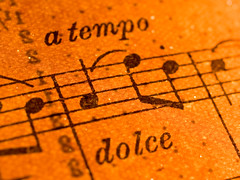[this is a version of a post which first appeared on my blog From the Front of the Choir]
I blame it on the Italians.

The founder of the modern musical stave was an Italian; many well-known musical forms — sonata, cantata, aria — were invented in Italy; also, Italian musicians and composers were in positions of prestige all over Europe, so Italian became the musical common language: presto, lento, adagio, forte.
Italy is where the terms Soprano, Alto, Tenor and Bass come from (SATB).
Apparently, before we British adopted the Italian system, genders used to be mixed up in harmony singing. You just sung whichever part felt right and it didn’t matter if men and women were in the same part. This gave rise to a much richer and more textured sound which suits some of the more robust folk and church singing from the past.
As I pointed out last week, there are no strict definitions of these voice ranges. To try and accommodate more vocal ranges, parts are even further sub-divided so we have 1st soprano and 2nd alto for instance. Basically, 1st is higher than 2nd within a particular vocal range.
When you’re trying to find out which is the most suitable part for you to sing, it’s not just about which notes you can reach.
During the warm up, the choir leader will gradually take you through a wide range of notes. Over the weeks you will often find that you will gradually be able to sing higher and lower than you first thought. As you warm up you will get a sense of which are the absolute highest and lowest notes that you are able to sing. You might be surprised!
This will give you an indication of which part you sing. If you find it easiest to hit the higher notes, then you probably belong in the ‘tops’ (soprano for women, tenor for men). If you find it hard to reach the extreme high and low notes, then you’re probably a middle (alto for women, bass for men). And if you find the low notes the easiest, then you’re probably a low lady (tenor) or a real bass man!
But this isn’t the whole story. I’ve mentioned the concept of tessitura in an earlier post Everybody has a place in the choir.
Tessitura basically means the range of notes that you feel most comfortable singing (i.e. without any kind of strain — your ‘sweet spot’) rather than the absolute range of notes that you can reach.
Last week, in But I can’t sing that high!, I pointed out that in most community choirs, everybody will probably be able to sing any of the parts, but there will be one part that you feel most comfortable with.
Many people come to singing with a huge number of preconceptions. When people say that they can’t sing at all, they usually mean they can’t sing as well as somebody famous, or they find it hard to reach the same notes as an opera singer, or that their voice doesn’t sound like their favourite pop star. You can read more about this in Why can't I sing?
Many women think that ‘proper’ singing is when you use your high ‘churchy’ voice. They think of opera singers with their soaring vibrato. So when they join a choir, they feel that they always need to be singing in their ‘choir voice’ which means just the high notes.
At school they might never have come across their ‘chest voice’ which is more akin to our speaking voices, and is the voice that is used in a lot of traditional singing, especially in Eastern Europe. Because they haven’t used this part of their voice much, it might appear ugly or feel unfamiliar, so they stick with what they know.
In some cases it might mean that a woman ends up singing with the tops even though she has an amazingly powerful low voice.
For many men with low voices, there simply aren’t enough role models out there. I have a reasonable range, and can sing quite low, but never much liked the singing of Paul Robeson when I was growing up. I was much more attracted to pop music and voices like those of The Beatles or David Bowie. So I tried to sing like them and found that there was no way I could hit the high notes that they did, so I assumed that I couldn’t sing. Many men are in this situation.
Most pop singers use their high tenor voice (and even drift off into falsetto like Thom Yorke, Tim Buckley, Rufus Wainwright, Antony Hegarty, etc.) and the most famous opera singers (like Pavarotti) are tenors. These ranges are usually beyond the reach of us mere mortals. Most men then think they can’t ‘sing’ properly or strain their voices trying to reach notes that are much too high for them.
Even if they like the low voices you can find in opera or Russian singing, most men can’t get down there. There just aren’t enough role models out there for us baritones!
Have you had difficulty in the past finding the right part for your voice? Do you find that the arrangements in your choir are either too high or too low for you? Do terms like ‘soprano’ and ‘bass’ put you off?
Do leave a comment, I’d love to hear of your experiences.
Chris Rowbury: chrisrowbury.com